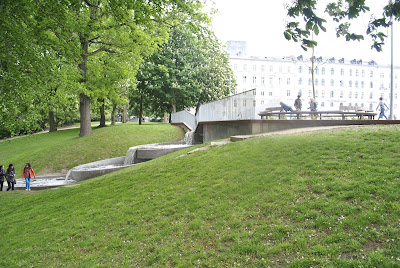What functions does
public urban greenspace perform in a city in general, and specifically in
Copenhagen?
In a crowded city, or a large urban area there is
always a debate on the need for a public urban greenspace or not. While some
people believe the need for a public urban greenspace is unnecessary, there are
plenty of reasons that go against that argument. While taking a tour of 5 of
Copenhagen’s urban public greenspaces in class, many of the functions of these
parks became clear and the need for the parks showed through.
 |
| Amaliehaven |
Whether a pocket park, a botanical garden or a
historic site turned park, a public greenspace, Copenhagen has a variety of
different kinds of parks that serve different needs of the public. The first
park we visited was Amaliehaven, which is a small park near the harbor that has
a peaceful vibe and allows for a quiet setting just outside the Royal Palace.
This particular park also offers a place to see a variety of different plants
and flowers. On our next stop, we visited Kastellet, a military fortress that
is now opened to the public as a place to relax, workout and see a part of
Copenhagen’s history. With the unique star shape of the park and the current
military presence, Kastellet is a place where people could enjoy the views of
Copenhagen, the harbor and the military section of the park.
 |
| Kastellet |
The third park we visited was Østre Anæg, which is different than either of the parks we previously
looked at. This park was covered in trees, surrounding a lake with plenty of
space for children to play. There was a small garden, a playground area for
children, and a number of trails and paths, all of which would make you feel as
one with nature. Even though the location of the park is in the middle of
Copenhagen, the secluded feeling of the park represents a place where urbanites
can get away and experience nature.
 |
| Østre Anlæg |
The fourth park we visited was called Botanisk
Have, a botanical garden. This botanical garden is in the center of the city
and like many of the other parks, it makes its visitors feel at peace with
nature. With a conservatory, a lake with a walking bridge, hills, flowers and
an open space for Danes to picnic, sun tan, relax or enjoy the park, the
botanical garden is a hotspot for Copenhagen’s citizens to enjoy themselves and
experience all of the nature it has to offer.
 |
| Botanisk Have |
The fifth and final park we saw on our tour was
Ørstedsparken. This park is just a bit different that the others because it
integrates the city and the park in one. The park is sunken into the ground,
which cancels out some of the noises of the city while and separates a peaceful
tranquil area from the hustle and bustle of the city. A man-made waterfall
flows from a concrete park alongside the city to the greenspace that is
Ørstedsparken. In addition to this park, I’ve also visited Rosenborg Castle
Gardens. Rosenborg Castle is one of the most visited parks in Copenhagen due to
its gardens and the historic site of the castle itself. Because King Christian
IV once resided in the castle, it is a historic site that draws in many viewers.
In the park, visitors can enjoy the gardens much like people have been doing
for years. In this park, tourists, like myself, can see many Danes enjoying
their days with friends and family, whether it’s on a picnic or taking in the
nature that surrounds them. Rosenborg Castle Gardens, along with the other
greenspaces I’ve mentioned is a great place for all of Copenhagen’s visitors to
go and see the beauty and peacefulness nature has to offer without leaving
Copenhagen itself.
 |
| Ørstedsparken |
The ammenities offered by these parks show just
how important parks are to a city, particularly Copenhagen. Copenhagen would be
much different if it did not have all of the greenspaces that it does, and the
greenspaces are just one of the factors that makes Copenhagen so great.


